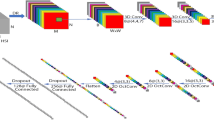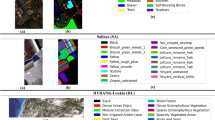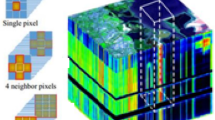Abstract
Hyperspectral remote sensing images (HRSI) are 3D image cubes that contain hundreds of spectral bands and have two spatial dimensions and one spectral dimension. HRSI analysis are commonly used in a wide variety of applications such as object detection, precision agriculture and mining. HRSI classification purposes to assign each pixel in HRSI to a unique class. Deep learning is seen as an effective method to improve HRSI classification. In particular, convolutional neural networks (CNNs) are increasingly used in remote sensing field. In this study, a hybrid 3D residual spatial–spectral convolution network (3D-RSSCN) is proposed to extract deep spatiospectral features using 3D CNN and ResNet18 architecture. Simultaneously spatiospectral features extraction is provided using 3D CNN. In deeper CNNs, ResNet architecture is used to achieve higher classification performance as the number of layers increases. In addition, thanks to the ResNet architecture, problems such as degradation and vanishing gradient that may occur in deep networks are overcome. The high dimensionality of the HRSIs increases the computational complexity. Thus, most of studies apply dimension reduction as preprocessing. In the proposed study, principal component analysis (PCA) is used as the preprocessing step for optimum spectral band extraction. The proposed 3D-RSSCN method is tested with Indian pines, Pavia University and Salinas datasets and compared against various deep learning-based methods (SAE, RPNet, 2D CNN, 3D CNN, M3D CNN, HybridSN, FC3D CNN, SSRN, FuSENet, S3EResBoF). As a result of the applications, the best classification accuracy among these methods compared in all datasets is obtained with the proposed 3D-RSSCN. The proposed 3D-RSSCN method has the best accuracy and time performance in classifying.







Similar content being viewed by others
Data availability
The datasets analyzed during the current study are available in the https://www.ehu.eus/ccwintco/index.php/Hyperspectral_Remote_Sensing_Scenes.
References
Chen C, Jiang F, Yang C et al (2018) Hyperspectral classification based on spectral–spatial convolutional neural networks. Eng Appl Artif Intell 68:165–171. https://doi.org/10.1016/j.engappai.2017.10.015
Jia J, Wang Y, Chen J et al (2020) Status and application of advanced airborne hyperspectral imaging technology: a review. Infrared Phys Technol 104:103115. https://doi.org/10.1016/j.infrared.2019.103115
Sun H, Ren J, Zhao H et al (2019) Superpixel based feature specific sparse representation for spectral-spatial classification of hyperspectral images. Remote Sens. https://doi.org/10.3390/rs11050536
Firat H, Uçan M, Hanbay D (2021) Hyperspectral image classification using MiniVGGNet. J Comput Sci IDAP:295–303
Fırat H, Hanbay D (2021) 4CF-Net: hiperspektral uzaktan algılama görüntülerinin spektral uzamsal sınıflandırılması için yeni 3B evrişimli sinir ağı. Gazi Üniversitesi Mühendislik Mimarlık Fakültesi Derg 1:439–453. https://doi.org/10.17341/gazimmfd.901291
Mohan A, MeenakshiSundaram V (2020) V3O2: hybrid deep learning model for hyperspectral image classification using vanilla-3D and octave-2D convolution. J Real Time Imag Process. https://doi.org/10.1007/s11554-020-00966-z
Gowtham B, Kumar IA, Reddy TS et al (2021) Hyperspectral image analysis using principal component analysis and siamese network. Turkish J Comput Math Educ 12:1191–1198
Firat H, Asker ME, Hanbay D (2022) Classification of hyperspectral remote sensing images using different dimension reduction methods with 3D/2D CNN. Remote Sens Appl Soc Environ. https://doi.org/10.1016/j.rsase.2022.100694
Mohan A, Venkatesan M (2020) HybridCNN based hyperspectral image classification using multiscale spatiospectral features. Infrared Phys Technol. https://doi.org/10.1016/j.infrared.2020.103326
Ahmad M, Khan A, Khan AM et al (2019) Spatial prior fuzziness pool-based interactive classification of hyperspectral images. Remote Sens 11:1–19. https://doi.org/10.3390/rs11091136
Li J, Bioucas-Dias JM, Plaza A (2010) Semisupervised hyperspectral image segmentation using multinomial logistic regression with active learning. IEEE Trans Geosci Remote Sens 48:4085–4098. https://doi.org/10.1109/TGRS.2010.2060550
Wang Y, Yu W, Fang Z (2020) Multiple Kernel-based SVM classification of hyperspectral images by combining spectral, spatial, and semantic information. Remote Sens. https://doi.org/10.3390/RS12010120
Ham JS, Chen Y, Crawford MM, Ghosh J (2005) Investigation of the random forest framework for classification of hyperspectral data. IEEE Trans Geosci Remote Sens 43:492–501. https://doi.org/10.1109/TGRS.2004.842481
Li Y, Zhang H, Shen Q (2017) Spectral-spatial classification of hyperspectral imagery with 3D convolutional neural network. Remote Sens. https://doi.org/10.3390/rs9010067
Zhao C, Wan X, Zhao G et al (2017) Spectral-spatial classification of hyperspectral imagery based on stacked sparse autoencoder and random forest. Eur J Remote Sens 50:47–63. https://doi.org/10.1080/22797254.2017.1274566
Data H, Chen Y, Lin Z et al (2014) Deep learning-based classification of hyperspectral data. IEEE J Sel Top Appl Earth Obs Remote Sens 7:2094–2107. https://doi.org/10.1109/JSTARS.2014.2329330
Mughees A, Tao L (2017) Efficient deep auto-encoder learning for the classification of hyperspectral images. In: 2016 international conference on virtual reality and visualization (ICVRV), 44–51. https://doi.org/10.1109/ICVRV.2016.16
Zhong P, Gong Z, Li S, Schonlieb CB (2017) Learning to diversify deep belief networks for hyperspectral image classification. IEEE Trans Geosci Remote Sens 55:3516–3530. https://doi.org/10.1109/TGRS.2017.2675902
Chen Y, Zhao X, Jia X (2015) Spectral-spatial classification of hyperspectral data based on deep belief network. IEEE J Sel Top Appl Earth Obs Remote Sens 8:2381–2392. https://doi.org/10.1109/JSTARS.2015.2388577
Li J, Xi B, Li Y et al (2018) Hyperspectral classification based on texture feature enhancement and deep belief networks. Remote Sens. https://doi.org/10.3390/rs10030396
Nogay HS, Akinci TC, Yilmaz M (2021) Detection of invisible cracks in ceramic materials using by pre-trained deep convolutional neural network. Neural Comput Appl. https://doi.org/10.1007/s00521-021-06652-w
Zhang C, Sargent I, Pan X et al (2019) Joint deep learning for land cover and land use classification. Remote Sens Environ 221:173–187. https://doi.org/10.1016/j.rse.2018.11.014
Firat H, Uçan M, Hanbay D (2021) Classification of hyperspectral remote sensing images using hybrid 3D–2D CNN architecture. J Comput Sci IDAP:132–140
Üzen H, Turkoglu M, Aslan M, Hanbay D (2022) Depth-wise squeeze and excitation block-based Efficient-Unet model for surface defect detection. Vis Comput. https://doi.org/10.1007/s00371-022-02442-0
Mu C, Guo Z, Liu Y (2020) A multi-scale and multi-level spectral-spatial feature fusion network for hyperspectral image classification. Remote Sens. https://doi.org/10.3390/RS12010125
Meng Z, Li L, Tang X et al (2019) Multipath residual network for spectral-spatial hyperspectral image classification. Remote Sens 11:1–19. https://doi.org/10.3390/rs11161896
Song W, Li S, Fang L (2018) Hyperspectral Image classification with deep feature fusion network. IEEE Trans Geosci Remote Sens 99:3173–3184. https://doi.org/10.1109/IGARSS.2019.8898520
Zhong Z, Li J, Luo Z, Chapman M (2018) Spectral-spatial residual network for hyperspectral image classification: a 3-D deep learning framework. IEEE Trans Geosci Remote Sens 56:847–858. https://doi.org/10.1109/TGRS.2017.2755542
Roy SK, Krishna G, Dubey SR, Chaudhuri BB (2019) HybridSN: exploring 3D-2D CNN feature hierarchy for hyperspectral image classification. arXiv 17:277–281
Ahmad M, Khan AM, Mazzara M et al (2020) A fast and compact 3-D CNN for hyperspectral image classification. IEEE Geosci Remote Sens Lett. https://doi.org/10.1109/LGRS.2020.3043710
Ge Z, Cao G, Li X, Fu P (2020) Hyperspectral image classification method based on 2D–3D CNN and multibranch feature fusion. IEEE J Sel Top Appl Earth Obs Remote Sens 13:5776–5788. https://doi.org/10.1109/JSTARS.2020.3024841
He M, Bo Li HC (2017) Multi-scale 3D deep convolutional neural network for hyperspectral image classification. IEEE Int Conf Image Process 2017:3904–3908
Firat H, Hanbay D (2021) 3B ESA Tabanlı ResNet50 Kullanılarak Hiperspektral Görüntülerin Sınıflandırılması classification of hyperspectral images using 3D CNN based ResNet50. In: 2021 29th signal processing and communications applications conference, p 6–9 https://doi.org/10.1109/SIU53274.2021.9477899
Luo F, Zhang L, Zhou X et al (2020) Sparse-adaptive hypergraph discriminant analysis for hyperspectral image classification. IEEE Geosci Remote Sens Lett 17:1082–1086. https://doi.org/10.1109/LGRS.2019.2936652
Liu S, Shi Q, Zhang L (2021) Few-shot hyperspectral image classification with unknown classes using multitask deep learning. IEEE Trans Geosci Remote Sens 59:5085–5102. https://doi.org/10.1109/TGRS.2020.3018879
Luo F, Zhang L, Du B, Zhang L (2020) Dimensionality reduction with enhanced hybrid-graph discriminant learning for hyperspectral image classification. IEEE Trans Geosci Remote Sens 58:5336–5353. https://doi.org/10.1109/TGRS.2020.2963848
Shi Q, Tang X, Yang T et al (2021) Hyperspectral image denoising using a 3-D attention denoising network. IEEE Trans Geosci Remote Sens. https://doi.org/10.1109/TGRS.2020.3045273
Shi Q, Liu M, Li S et al (2021) A deeply supervised attention metric-based network and an open aerial image dataset for remote sensing change detection. IEEE Trans Geosci Remote Sens. https://doi.org/10.1109/TGRS.2021.3085870
He K, Zhang X, Ren S, Sun J (2016) Deep residual learning for image recognition. In: Proceedings of the IEEE computer society conference on computer vision and pattern recognition. IEEE computer society, pp 770–778
Sun W, Du Q (2018) Graph-regularized fast and robust principal component analysis for hyperspectral band selection. IEEE Trans Geosci Remote Sens 56:3185–3195. https://doi.org/10.1109/TGRS.2018.2794443
Rodarmel C, Shan J (2002) Principal component analysis for hyperspectral image classification. Surv L Inf Sci 62:115–122
Zhang Y, Jiang X, Wang X, Cai Z (2019) Spectral-spatial hyperspectral image classification with superpixel pattern and extreme learning machine. Remote Sens. https://doi.org/10.3390/rs11171983
Appice A, Malerba D (2019) Segmentation-aided classification of hyperspectral data using spatial dependency of spectral bands. ISPRS J Photogramm Remote Sens 147:215–231. https://doi.org/10.1016/j.isprsjprs.2018.11.023
Uddin MP, Al MM, Hossain MA (2020) PCA-based feature reduction for hyperspectral remote sensing image classification. IETE Tech Rev Inst Electron Telecommun Eng India. https://doi.org/10.1080/02564602.2020.1740615
Uddin MP, Mamum MA (2017) Feature extraction for hyperspectral image classification. 2021IEEE Reg 10 Humanit Technol Conf 41:6248–6287. https://doi.org/10.1080/01431161.2020.1736732
Jia X, Kuo BC, Crawford MM (2013) Feature mining for hyperspectral image classification. Proc IEEE 101:676–697. https://doi.org/10.1109/JPROC.2012.2229082
Kang X, Xiang X, Li S, Benediktsson JA (2017) PCA-based edge-preserving features for hyperspectral image classification. IEEE Trans Geosci Remote Sens 55:7140–7151. https://doi.org/10.1109/TGRS.2017.2743102
Melgani F, Bruzzone L (2004) Classification of hyperspectral remote sensing images with support vector machines. IEEE Trans Geosci Remote Sens 42:1778–1790. https://doi.org/10.1109/TGRS.2004.831865
Chen Y, Lin Z, Zhao X et al (2014) Deep learning-based classification of hyperspectral data. IEEE J Sel Top Appl Earth Obs Remote Sens 7:2094–2107. https://doi.org/10.1109/JSTARS.2014.2329330
Xu Y, Du B, Zhang F, Zhang L (2018) Hyperspectral image classification via a random patches network. ISPRS J Photogramm Remote Sens 142:344–357. https://doi.org/10.1016/j.isprsjprs.2018.05.014
Makantasis K, Karantzalos K, Doulamis A, Doulamis N (2015) Deep supervised learning for hyperspectral data classification through convolutional neural networks. In: 2015 IEEE international geoscience and remote sensing symposium (IGARSS), pp 4959–4962. https://doi.org/10.1109/IGARSS.2015.7326945
Ben Hamida A, Benoit A, Lambert P, Ben Amar C (2018) 3-D deep learning approach for remote sensing image classification. IEEE Trans Geosci Remote Sens 56:4420–4434. https://doi.org/10.1109/TGRS.2018.2818945
Roy SK, Dubey SR, Chatterjee S, Chaudhuri BB (2020) FuSENet: Fused squeeze-and-excitation network for spectral-spatial hyperspectral image classification. IET Image Process 14:1653–1661. https://doi.org/10.1049/iet-ipr.2019.1462
Roy SK, Chatterjee S, Bhattacharyya S et al (2020) Lightweight spectral-spatial squeeze-and-excitation residual bag-of-features learning for hyperspectral classification. IEEE Trans Geosci Remote Sens 58:5277–5290. https://doi.org/10.1109/TGRS.2019.2961681
AbdElaziz M, Dahou A, Abualigah L et al (2021) Advanced metaheuristic optimization techniques in applications of deep neural networks: a review. Neural Comput Appl 33:14079–14099. https://doi.org/10.1007/s00521-021-05960-5
Author information
Authors and Affiliations
Contributions
All the authors contributed equally to this study.
Corresponding author
Ethics declarations
Conflict of interest
The authors declared that they have no conflicts of interest in this study. We declare that we do not have any commercial or associative interest that represents a conflict of interest in connection with the work submitted.
Additional information
Publisher's Note
Springer Nature remains neutral with regard to jurisdictional claims in published maps and institutional affiliations.
Rights and permissions
Springer Nature or its licensor (e.g. a society or other partner) holds exclusive rights to this article under a publishing agreement with the author(s) or other rightsholder(s); author self-archiving of the accepted manuscript version of this article is solely governed by the terms of such publishing agreement and applicable law.
About this article
Cite this article
Firat, H., Asker, M.E., Bayindir, M.İ. et al. 3D residual spatial–spectral convolution network for hyperspectral remote sensing image classification. Neural Comput & Applic 35, 4479–4497 (2023). https://doi.org/10.1007/s00521-022-07933-8
Received:
Accepted:
Published:
Issue Date:
DOI: https://doi.org/10.1007/s00521-022-07933-8




